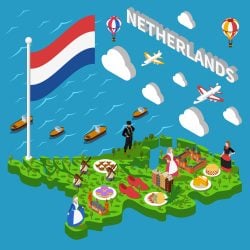Dutch Dialects: Everything you Need to Know About the Main Varieties of the Dutch Language
Very often, English learners travel to places like California hoping to put their language skills into practice only to find that the English spoken there has little to do with the English they’ve learned at school. Though this could be a bit frustrating, it is only natural, and it happens with every language.
Depending on what country or region you travel to, or even what kind of people you talk to, you could find different varieties of almost every language. RP English, the standard variety of British English taught at most language schools, differs greatly from Californian English the same way Castilian Spanish differs greatly from the variety spoken in Peru.
With Dutch, the West Germanic language spoken in The Netherlands, it’s the same story. After all, this language is spoken by 23 million native speakers only in The Netherlands and Belgium. You didn’t expect all these people to talk the same way, did you?
Below, you will find a list of the main Dutch dialects that you might find in The Netherlands, northern Belgium, Suriname, and some Caribbean countries.
Hollandic
This Dutch dialect spoken in the region of Holland is one of the most popular varieties of the language. The original form of this dialect was heavily influenced by a West Frisian subdialect as well as some Brabantian dialects. Its present-day form can be heard in important urban areas such as Amsterdam and Rotterdam where it bears a closer resemblance to the standard variety of Dutch that you would hear on television. The Hollandic dialect will present no major problems to foreign travelers familiar with Dutch, as it is the most common dialect to be learned at language schools.
Brabantian
After Hollandic, Brabantian is the most widely spoken Dutch dialect in the world. This variety is used across a wide geographical area spanning from the southern region of the Netherlands into Belgium. It is estimated that Brabantian is used by more than 5 million people.
Given that this Dutch dialect is spoken in a relatively large area, Brabantian can be roughly subdivided into three smaller varieties which present minor differences. These are West Brabantian, East Brabantian, and South Brabantian.
No matter which Brabantian subdialect you find in your travels through Belgium and The Netherlands, there is one typical phrase you are bound to hear whose meaning you should be aware of if you want to start with the right feet. The expression houdoe, which comes from houd u geod (keep yourself alright), is a common form of saying goodbye, not unlike “take care of yourself” in English. In contrast, other Dutch dialects such as Hollandic more commonly use deoi (bye) in the same contexts.
Surinamese Dutch
As its name indicates, this is the variety of Dutch spoken in Suriname, a former Dutch colony. Dutch was adopted as the language of communication between Native Surinamese, African slaves, and the Dutch government, which colonized Suriname in the 17th century. In 1876, Dutch also became official to be taught to children in schools.
Dutch is spoken as a native language by around half of the population, although most of them also speak other languages such as Sranan Tongo, Hindustani, and Javanese, among others. However, Dutch remains the only official language of the country.
Surinamese Dutch differs from other popular varieties of Dutch in that Surinamese speakers, being a multiracial and multilingual society, are known for copiously borrowing words and phrases from other languages also spoken in Suriname.
This dialect also presents some phonological differences that set it apart from other standardized varieties. For example, the sounds v and z, which are produced with a vibrating sound in Standard Dutch (and in English), are pronounced as f and s in this variety.
Dutch Dialects?
West Flemish is spoken by about a million people in the West Flanders region of Belgium. Though it is often described as a Dutch dialect, it is so different from Hollandic and Barbantian that it would be very difficult for speakers of these varieties to understand what someone who speaks West Flemish says. Actually, when TV programs in West Flemish are shown in regions where other dialects are spoken, they often use subtitles. As a result, linguists often disagree on the subject of whether this dialect should be classified as a Dutch dialect or an independent language.
Limburgish, spoken around the border of the Netherlands, Belgium, and Germany, has long been subject to similar debates, as its significant influence on German makes it tempting to say that it is, in fact, a variant of that language. Most scholars, however, still define it as a Dutch dialect.
Dutch is often described as one of the easiest languages to learn for native and non-native speakers of English. This is because both languages share a lot of lexical and grammatical characteristics. Still, if you want to achieve fluency in Dutch, don’t go at it alone: as usual, the best way to learn a language in depth is to take a tailor-made course with a native tutor. So, send a quick inquiry our way and we’ll get right back at you with a lesson plan devised specifically to meet your needs.


